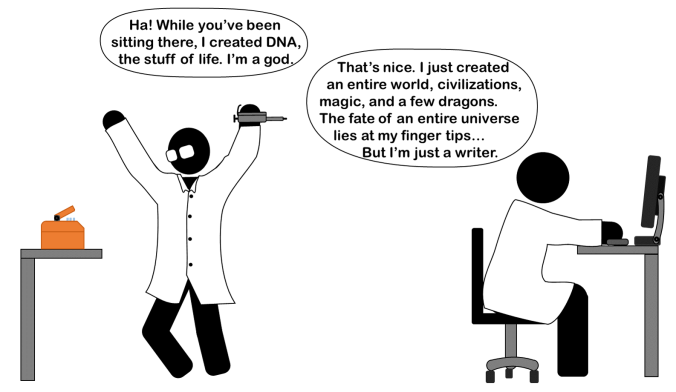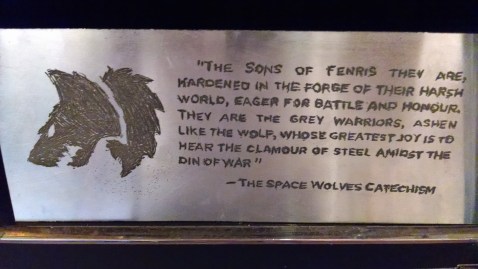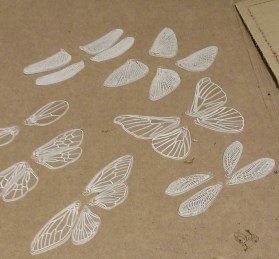
As writers, we have a penchant for creating things. Seeing something of your own imagination brought into the world provides such a sense of satisfaction that, for many of us, it has become a drug. When we need a fix, we simply pull out our computers or notebooks and let our imaginations spill out onto the page. We can create entire worlds and cultures, magic, and new laws of science, but sometimes we encounter writer’s block, or the act of writing is no longer enough to satisfy the craving. To keep withdrawal from setting in, many of us seek a creative outlet in the real world. If you suffer from this creation addiction, here are some tips on how to expend your pent-up creativity in a safe and productive manner.
Arts and crafts
One of the easiest ways to sate your creative impulses, is to take up arts and crafts. This includes any hobby that involves the creation of objects, not the intangible ones to which we writers are accustomed. Whether it involves glue, thread, needles, wood, metal, or glass, or paint or graphite, these mediums can be used to exercises your inner creative muscles.
I have tried my hand at lampwork (melting glass with a torch), pen making, sculpting, whittling, mold making and casting, and many more. But for me, the most satisfying form of arts and crafts is etching. I have etched images and text into metal (saltwater etching and electroplating), glass (chemical) and wood (wood burning), and even cloth (screen printing).

An aluminum saltwater etching I made for a friend, quoting the Space Wolves Catechism from Warhammer 40K
Until recently, I have been doing this the hard way, but I came across this laser etching service called Ponoko, where I can have all kinds of materials laser etched to create key-chains, jewelry, game pieces, prototypes, etc.

Insect wings cut and etched into acrylic by Ponoko. I gave these to my girlfriend who enjoys making earrings.

Leather key-chains with a P kissing an M for me and my girlfriend, Megan.
Food
There is no creation as immediately gratifying as food. While you can enjoy food cooked by anyone, that urge to create something is not satisfied unless you do it yourself. Heating a microwave dinner or mixing a couple ingredients provided in a box don’t count. I don’t have a wealth of culinary skills, but I do like to experiment in the hopes of coming up with a new taste. I get the most enjoyment out of cooking something from scratch. Take a pizza for example. It takes no creative effort to order one or heat it in the oven. Instead, try making the dough yourself (water, yeast, flour, and some sugar and salt), the pizza sauce (tomatoes, salt, and herbs), and then cheese and toppings. I’m proud to say that I’ve made an entire pizza from scratch a few times, including the cheese. I hope that one day I will be able to plant, reap, and process my own grain into flour, too. Want an adult beverage with your pizza dinner, stop by a home-brew supply store and brew your own wine, beer, mead, or cider.
Growing your own herbs, fruits, and vegetables is also a rewarding process. Even if the plants are decorative, allowing them to flourish provides the same sense of accomplishment.
Creating with friends and family
If you are a mother or father, congratulations, you have successfully brought life into the world, you are a creator. I do not advise expending your creative urges in this manner all the time, however. Instead, try the following collaborative projects:
– coming up with stories at bedtime
– create your own board or card games
– start a band and write music
– come up with science fair projects
– have art projects or arts and crafts nights
– play Minecraft or other sandbox games
– DIY projects around the house.
At work
If you have a job where you are paid to create (e.g. engineer, artist), then you probably aren’t lacking in creative outlets. In the lab, I get to make figures and schemes and presentations to accompany my research data. For many of you, there will be many opportunities to exercise your creativity at work. You can volunteer to put together a logo, a presentation, a memo, an advertisement, or anything else that requires a bit of imagination and implementation. If your job doesn’t offer those kinds of opportunities, it can be as simple as making cookies for your colleagues, customizing cards for special occasions, or decorating office space or attire, designing a business card with interesting graphics, or printing t-shirts for company getaways.
I once made a motivational poster of my boss peering down the barrel of a Nerf gun, with the words “stay focused” written beneath. Soon, everyone in the lab was requesting motivational posters with their own sayings. I also cultivated a line of petri -dish Jade bonsais that have since been spread to multiple labs as a window seal decoration.

To supplement your writing
Of course, these creative projects should not impinge on your writing time, marketing, or other author responsibilities. However, you can supplement your writing with these creative projects to help sell your brand. You can focus your arts and crafts on making things specific to your fantasy or scifi world. If you describe a piece of jewelry or attire, try to make it. If you have a saying, motto, or logo, or book cover, print it on t-shirts, mugs, poster, etc. Perhaps you can sell these items on your website, or offer them as giveaways. That way when people show off these items, it will further advertise your book. You can even draw sketches of your characters, paint a scene, draw a map, or design a cover for your book. Do you make music and have a bunch of audio equipment? Turn your novel into an audiobook. If you like to cook, make the dishes you describe in your world and write a cookbook. Not only will you be able to describe the taste of such a dish in detail, you can describe the making of it.

A leather cover for the first round of edits of my first book.
It is difficult to be creative in today’s world; everything is made for us, processed within an inch of unrecognizable and provided with instructions as simple as “just add water.” It is no wonder the simple process of creation eludes many of us on a day to day basis. Writing can only satisfy our addiction for so long before we begin drawing inventions on the back of napkins or building a castle of epic proportions on Minecraft.
Are you an creation addict? How do you expend your excess creativity?




